|
|
|
Sort Order |
|
|
|
Items / Page
|
|
|
|
|
|
|
| Srl | Item |
| 1 |
ID:
103127
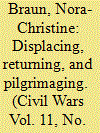

|
|
|
|
|
| Publication |
2009.
|
| Summary/Abstract |
This article analyses the repatriation of a group of internally displaced persons which took place in 2003 in north-western Colombia. Starting with the question of why, in spite of all reservations, the displaced families were taken back to a war zone, the author demonstrates how, on the one hand, the repatriation was part of a power game between the protagonists in the armed conflict and how, on the other, the return of the families was a way of resisting the violent social orders that the paramilitary, the army and the guerrillas had established in the region. The repatriation was the starting point for the creation of a social order based on non-violence. Thus it was the scene of a struggle about social orders or, to put it in another way, about the principles on which Colombian society should be based - a struggle fought out with violent and non-violent means.
|
|
|
|
|
|
|
|
|
|
|
|
|
|
|
|
| 2 |
ID:
103128
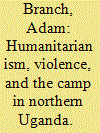

|
|
|
|
|
| Publication |
2009.
|
| Summary/Abstract |
This article shows how international humanitarianism and state violence developed a sustained relation of mutual support during the civil war in northern Uganda. This collaboration was anchored in the archipelago of forced displacement camps, which at the peak of the war contained about a million people, and which were only able to exist because of, first, the violence of the Ugandan state in forcing people into them, preventing people from leaving, and repressing political organisation in the camps; and, second, the intervention of international humanitarian aid agencies, which fed, managed, and sustained the camps for over a decade. The consequence was that state violence and international humanitarianism each depended on the other for its own viability.
|
|
|
|
|
|
|
|
|
|
|
|
|
|
|
|
| 3 |
ID:
103126
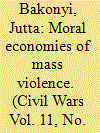

|
|
|
|
|
| Publication |
2009.
|
| Summary/Abstract |
The focus in the article is on the beginning and expansion of the Somali war between 1988 and 1992. Three patterns and dynamics of mass-mobilisation are comparatively examined: the relatively sudden transformation of the northern guerrilla struggle in a civil war 1988, the expansion of the war to the southern region after 1989 and the mass-upheaval in Mogadishu 1990/91. Although clan-affiliation became a prominent tool to mobilising violence and to framing friends and foes throughout Somalia, the patterns of organising clan-relations within the insurgent movements and between the movements and the non-armed population differed and laid the basis for the different trajectories of violence in the Somali regions.
|
|
|
|
|
|
|
|
|
|
|
|
|
|
|
|
| 4 |
ID:
103124
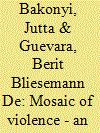

|
|
|
| 5 |
ID:
103131
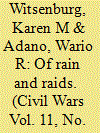

|
|
|
|
|
| Publication |
2009.
|
| Summary/Abstract |
In the face of the current focus on climate change, the question whether climate variations have effects on ethnic violence is addressed. This article shows the results of an empirical study on the relationship between violent livestock raiding and climatic conditions. The practice of livestock raiding causes large numbers of casualties in northern Kenya. While conflicts over scarce resources may be largely explained by drought conditions, population pressure, and access problems, livestock raiding is more violent during wet seasons, when pasture and water are abundant and when the livestock is in good health. The higher incidence of violent deaths during wet times hints at opportunistic behaviour of raiders.
|
|
|
|
|
|
|
|
|
|
|
|
|
|
|
|
| 6 |
ID:
103125
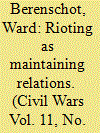

|
|
|
|
|
| Publication |
2009.
|
| Summary/Abstract |
This article discusses the role that local politicians played during the 2002 Hindu-Muslim violence in Gujarat, India. I argue that the capacity and interests of political actors to instigate and organise communal rioting is closely related to their capacity to provide access to state resources. The cooperation during the riots between politicians and various types of rioters - from local criminals, Hindu-nationalist activists, neighbourhood leaders to police officials - can be understood in the light of the daily functioning of the local patronage networks that help citizens deal with state institutions.
|
|
|
|
|
|
|
|
|
|
|
|
|
|
|
|
| 7 |
ID:
103129
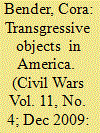

|
|
|
|
|
| Publication |
2009.
|
| Summary/Abstract |
Based on my own earlier theorising of 'mimesis at war', and taking up Simon Harrison's suggestion that trophies made from human body parts are best explained as 'transgressive objects', the article focuses on a particular trophy, a nineteenth century Cheyenne finger necklace. Its history illustrates that trophy-taking was part of a broader circulation of practices of war among native warriors and the American military in the West. Finally, trophy-taking made its way into the academic and scientific institutions that provide the discursive frame for present debates about war in anthropology and archaeology.
|
|
|
|
|
|
|
|
|
|
|
|
|
|
|
|
|
|
|
|
|